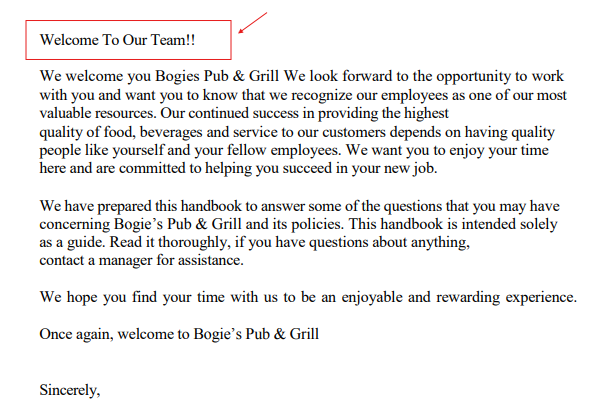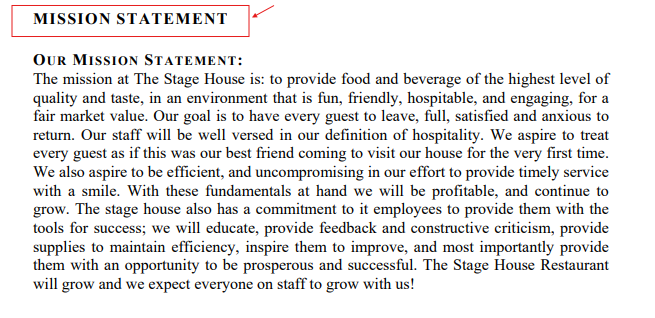Key Takeaways
- A restaurant employee handbook ensures structure and compliance, helping avoid fines, improve efficiency, and create a positive work environment.
- Standardized training and restaurant employee guidelines reduce costly mistakes, ensuring new hires correctly handle orders, customer service, and food safety.
- Covering key sections like mission, conduct, safety, and compensation keeps everyone aligned and reduces risks like harassment, scheduling conflicts, and wage disputes.
- Defining roles and responsibilities boosts productivity, leading to smoother operations, happier employees, and better customer experiences.
"When there’s no structure to handle more orders, the best employees end up doing the most—until they burn out and quit."
High turnover strains teams, overwhelms new hires, and creates chaos that customers notice. Disorganized operations lead to slower service, mistakes, and frustration.
The root cause? A lack of structure.
Over half of employees report feeling lost (56%) or let down (52%) during onboarding. A clear, well-designed restaurant employee handbook fixes this—defining roles, setting standards, and creating consistency. The result: smoother operations, happier staff, and better customer experiences.
Before we draft an employee handbook, let's examine the most common legal challenges restaurant owners face.
What is a Restaurant Employee Handbook?
Simply put, a restaurant employee handbook is your go-to guide for running a smooth workplace. It lays out everything your team needs to know:
- Rules and policies (attendance, dress code, conduct)
- Legal requirements (labor laws, safety guidelines)
- Training and procedures (food handling, customer service)
- Restaurant's mission and core values.
A well-crafted handbook keeps everyone on the same page, from new hires to long-time staff, reducing confusion, miscommunication, and legal risks.
Ensuring a fair, consistent work environment is especially important during key phases like onboarding, performance reviews, and resignations.
Restaurant Handbook Compliance: Keeping Up with Changing Regulations
Keeping a restaurant employee handbook up to date requires ongoing maintenance since regulations change frequently at federal, state, and local levels, sometimes multiple times a year.
Here are a few common compliance challenges:
- Opening in a new city may introduce different minimum wage laws.
- Expanding beyond 50 employees triggers Family and Medical Leave Act (FMLA) obligations.
- Operating in a major city may require compliance with fair workweek laws.
- Reaching certain employee thresholds can mandate new benefits and workplace policies.
- Restaurant owners have encountered significant penalties due to unintentional violations of wage and hour laws. Miscalculations in overtime pay or misunderstandings about tip credits can lead to substantial fines.
- Independent restaurants often struggle with HR compliance, leading to potential fines and legal battles.
- The Department of Labor's regulations on dual jobs and the 80/20 rule make it challenging to draft a handbook that clearly defines when an employee qualifies for the tipped minimum wage and when they must be paid the full minimum wage.
Navigating these regulatory challenges can feel overwhelming, but having a structured restaurant employee handbook helps simplify compliance, set clear expectations, and create a more organized workplace. So,
Why Does Your Restaurant Need a Restaurant Employee Handbook?
Without an employee handbook, your team faces confusion due to inconsistent workplace standards and the risk of costly fines increases. A well-structured handbook keeps everyone aligned, minimizes miscommunication, and helps maintain a professional, legally compliant work environment. Here's why it matters:
1. Avoid Fines or Penalties
Non-compliance with labor laws like wage regulations or child labor restrictions can cause substantial fines. For instance, in 2024, Burger King and Popeyes franchises faced fines totaling $2 million for several labor law violations. A restaurant employee handbook with all region-specific laws compiled saves you hefty dollars that could've been spent on fines.
2. Smooth Onboarding: Consistent Training for New Hires
An untrained new hire can slow service, mishandle online orders, or miss food safety steps all of which hurt customer satisfaction and your bottom line.
A well-structured employee handbook creates consistent training, which is key when introducing online ordering. Be sure it covers the benefits of digital order management, provides demos, and includes follow-up training so staff can deliver fast, reliable service and protect your reputation.
Pro Tip: RestoLabs makes managing online orders easy from day one but your team still needs training to get it right.
3. Promote Workplace Quality and Culture
When employees feel respected, they work better and build a stronger team. But without clear policies, a workplace can quickly turn toxic — with serious consequences.
Case in point: Gregory Coffee, a 50-location chain, faced a lawsuit over discrimination and harassment, highlighting why restaurants must have clear anti-discrimination and harassment policies.
Consult an attorney to ensure your policies protect your staff and shield your business from lawsuits or fines.
Now that we've covered why having a restaurant employee handbook is important, the next big question is: What exactly should go into it?
7 Sections To Include In The Restaurant Employee Handbook
While there's no one-size-fits-all approach to formatting a restaurant employee handbook, most contain these eight sections to ensure compliance and clarity.
1. Introduction, Welcome Letter
Begin with a warm introduction that reflects your restaurant's story and philosophy. Set the stage for what the handbook covers while keeping the tone welcoming and engaging.
Take Bogies Pub & Grill's employee handbook as an example. It starts with a simple, easy-to-follow introduction that welcomes the employees and also addresses how the handbook intends to be a guide to some of the common questions employees may have. It's followed by a table of contents that clearly explains everything the handbook covers.

Note: Include a disclaimer that the handbook isn't a legally binding contract but a document demonstrating mutual understanding. Failing to do so can result in an employee suing you for breach of contract.
2. Mission Statement And Core Values
After welcoming the employees, go through a mission statement that defines a restaurant's core values and sets the foundation for its company culture, customer service standards, and workplace ethics.
Here's an example from the Stage House Tavern, a restaurant in the United States. Their mission statement outlines the restaurant's aspirations and how employees will receive education and feedback to support their growth alongside the business.

3. Code Of Conduct
This is one of the most important sections as it explains to your employees how to behave and the standards they should adhere to. For example, Starbucks addresses the guidelines to ensure the work environment is free of bullying, harassment, and discrimination that take many forms, including,
- Unwelcome remarks, gestures, or physical contact
- The display or circulation of offensive, derogatory, sexually explicit, or suggestive pictures or other materials, including by email, messaging service, and social media
- Offensive or derogatory jokes, comments, or gestures (explicit or by innuendo)
- Verbal or physical abuse or threats
- Less favorable treatment based on a protected personal characteristic or status Public release of targeted individuals' personal, sensitive or private information Improperly undermining or endangering another's job, job performance, or career
Apart from these, you can even curate guidelines around:
- Smoking
- Alcohol and drugs
- Cell phone usage
- Social media usage
- Employee meals
- Weapons policy, etc.
You can add or remove sections that fit your establishment.
4. Procedures And Emergencies
This handbook covers daily restaurant operations management, including employee scheduling, safety, and sanitation. It should also include:
- Staff scheduling
- Health, sanitation, and allergy protocols
- Meetings
- Opening and closing checklists
- Emergencies
- Meetings
- Missed shifts
- Theft or robbery
- Fire safety protocols
Managing these guidelines requires careful attention, even for a single-location restaurant, and becomes even more complex when overseeing multiple locations. Consult an attorney when curating this section to ensure your scheduling procedures adhere to state-specific guidelines.
💡Pro Tip: In multi-location operations, investing in a direct ordering system like RestoLabs helps standardize online ordering across all branches. With its centralized management of menus, operations, and staff, restaurant owners can apply handbook policies uniformly across all locations.
5. Leave Policy And Guidelines
While there is no federal mandate in the USA requiring private employers to provide paid sick leave or vacation, several states have implemented their regulations.
Source: National Conference of State Legislatures (NCSL) – Paid Sick Leave Laws in the States.
The sick leave policies should clearly define eligibility, the process for notifying management, and whether a doctor's note is required for extended absences. Similarly, vacation policies should outline how time off is accrued, any blackout dates, such as peak holiday seasons, and whether unused days can roll over.
6. Safety Guidelines
Safety guidelines are a core part of running a successful, responsible restaurant. From handling workplace injuries to safely managing kitchen equipment, your employee handbook should clearly outline safety protocols to protect your staff and business.
Start by incorporating Occupational Safety and Health Administration (OSHA) guidelines, which set the foundation for a safe working environment. Be sure to include protocols for handling sharp objects, hot surfaces, cleaning chemicals, food safety practices, and emergency procedures.
Moreover, the Centers for Disease Control and Prevention (CDC) recommends providing easy-access sinks and sufficient soap and gloves to encourage hand washing and glove use.
These guidelines help prevent accidents and reinforce a culture of safety and responsibility.
Note: Explore restaurant-specific safety recommendations here to ensure your team stays protected.
7. Employee Compensation And Benefits
Tipping policies, promotions, and performance-based raises are crucial in keeping your staff motivated and fairly compensated. But managing these alongside ever-changing local, state, and federal wage laws can quickly become complex
For instance, you need to check the minimum wage requirements, especially for tipped employees, and overtime pay for those who work more than 40 hours a week, as outlined under the Fair Labor Standards Act (FLSA). Additionally, minimum wage rates vary by state, so understanding and adhering to local regulations is just as important.
Source: Minimum Tipped Wages ; California Overtime
Also, ensure you adhere to Equal Employment Opportunity (EEO) guidelines. These laws protect employees and job applicants from discrimination based on race, color, religion, sex (including pregnancy, sexual orientation, or gender identity), national origin, age, disability, or genetic information.
Staying on top of these rules is key to avoiding penalties and maintaining a positive work environment.
Note: Some states, like California and Washington, don't allow tip credits and require full minimum wage for all employees. Overtime rules also vary—some states mandate daily thresholds rather than the standard 40-hour workweek rule.
Key Practices to Draft Your Restaurant Employee Handbook
Creating a handbook is just the start; how you implement it matters just as much. Take these pointers into consideration:
While these practices and templates help refine the handbook, they require customization to align with your restaurant's unique policies and compliance needs. That's where Restolabs comes in. With Restolabs, you can streamline restaurant operations, which can, in turn, help you create well-structured guidelines for your workflow.
RestoLabs: Helping Restaurants Grow & Scale
A well-structured employee handbook sets the foundation for smooth operations — but growth also depends on having the right tools in place. That’s where RestoLabs comes in.
We help restaurants simplify order management, improve efficiency, and deliver a consistent guest experience, whether you run a single location or a growing chain. Our zero commission online ordering system is built to save you money, boost revenue, and keep customers coming back.
From streamlining daily workflows to making multi-location management seamless, RestoLabs gives you the operational edge you need to scale with confidence.
Let’s talk about how we can help your restaurant grow — book a consultation today.
Frequently Asked Questions


.gif)
.png)
.png)
.png)

.png)




